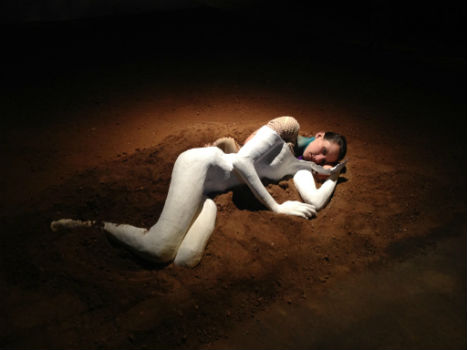Part III: There Is Nowhere to Eat in the Lower East Side
"No One to Witness..." study at gloATL, December 2012
"How much of what I saw at On the Boards is still there?" I asked Zoe as we walked down a street in the Lower East Side about an hour after our show ended.
We'd gone to see the newest work by an artist I've followed for a couple years, Arturo Vidich. Zoe and I sat in the part of the audience signalling our willingness to participate in the work. I wasn't worried about being chosen (since Arturo clearly wasn't going to pick me--I already knew the gambit), but Zoe in fact got picked to be one of two participants, leaving me to wincingly watch her drawn into a highly physical improvisational task by Arturo and wondering what it would mean if I, having taken her out, wound up letting her break an ankle or something.
Arturo choose his participants using a "psychic" technique: placing his forehead against each potential participant and psychically asking the person whether they're willing to take part. Mind you, Arturo has never evinced any particular belief in the actual psychic channeling of this moment to me; rather, he claims he's used it many times, from back in his clowning days, and it always works. Whatever he reads, he reads right, and though Zoe assured me she did her best to channel "don't pick me" to him, she indeed did perform with aplomb.
"Not much," she responded to my question about the August residency.
Which of course left me thinking, “Well what the hell am I supposed to write about now?”
I stopped at the corner and looked around, trying to find the rest of our erstwhile crew. Jay Wegman, the artistic director of Abrons Arts Center, which presented Arturo's show, had invited us and about ten other people out to dinner afterward, but it was about halfway through having each of our bags searched at the door to the restaurant--delayed by two separate arguments over bringing in bottled water (never heard that one before)--that we realized our restaurant had become, since Jay's last visit, just another b&t nightclub, and his "dinner reservation" was really just "table service." He left, irritated but snickering at the maitre d', who informed him of their cancellation policy ($15 a head), not realizing they'd failed to take down Jay's credit card when making the reservation.
This, however, left us in the unenviable position of wandering the LES on a Saturday night just shy of ten o'clock, looking for a restaurant that could accommodate a dozen people without prior reservation. An impossible proposition. Sometimes when I find myself wandering around that neighborhood on a weekend night the lyrics to Santigold's "L.E.S. Artistes" pop into mind and I start chuckling, but truth be told there's nary a hint of the neighborhood's one-time reputation as an artist's redoubt to be found these days. I can still tolerate the East Village and Alphabet City north of Houston St., but the Lower East Side, aside from when I want to take someone dancing at Mehanata, is unbearable.
"But is it still dark?" I ask Zoe. She gave me a curious look. "I mean, most of the design was really dark, like shifting the movement to video, shadow-play, bi-secting the body with light, the sort of thing."
"I don't think so," she replied. "Not anymore."

